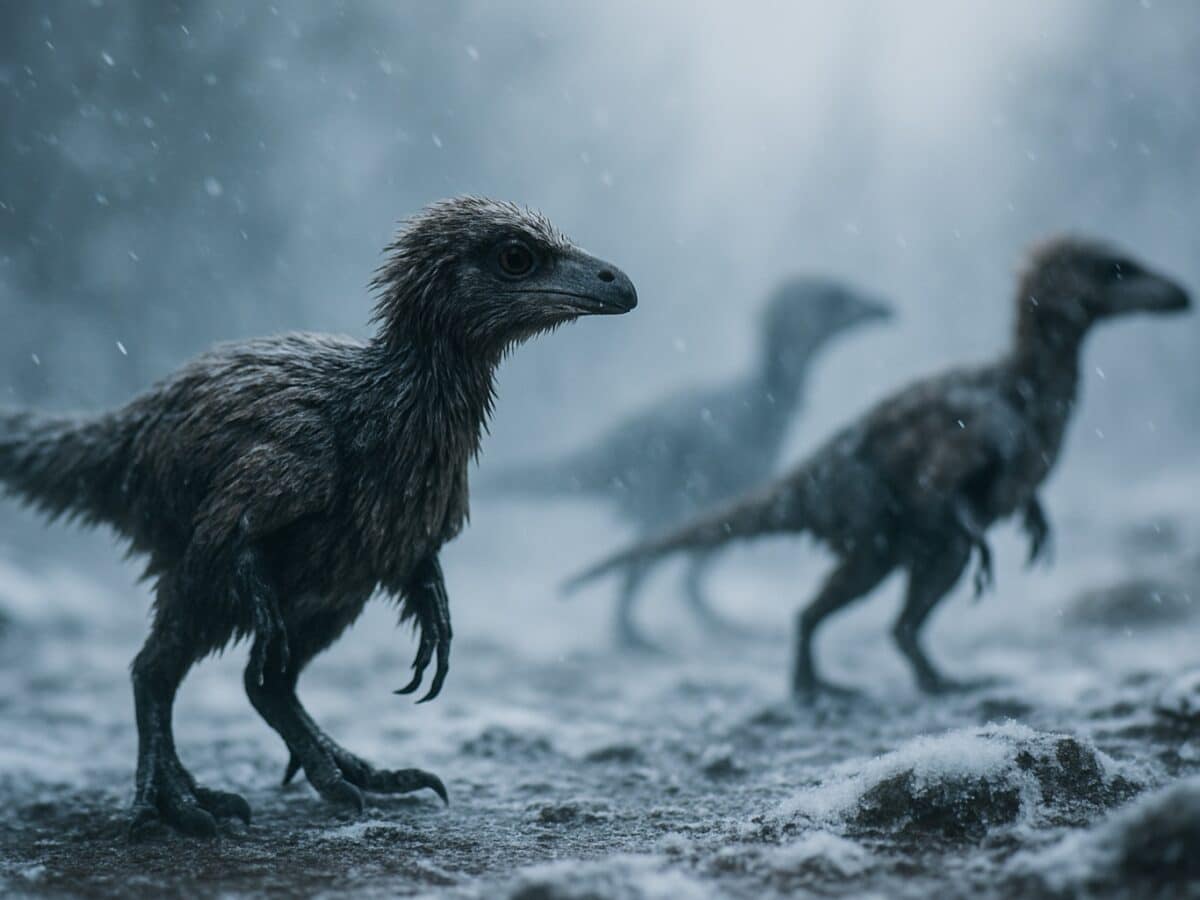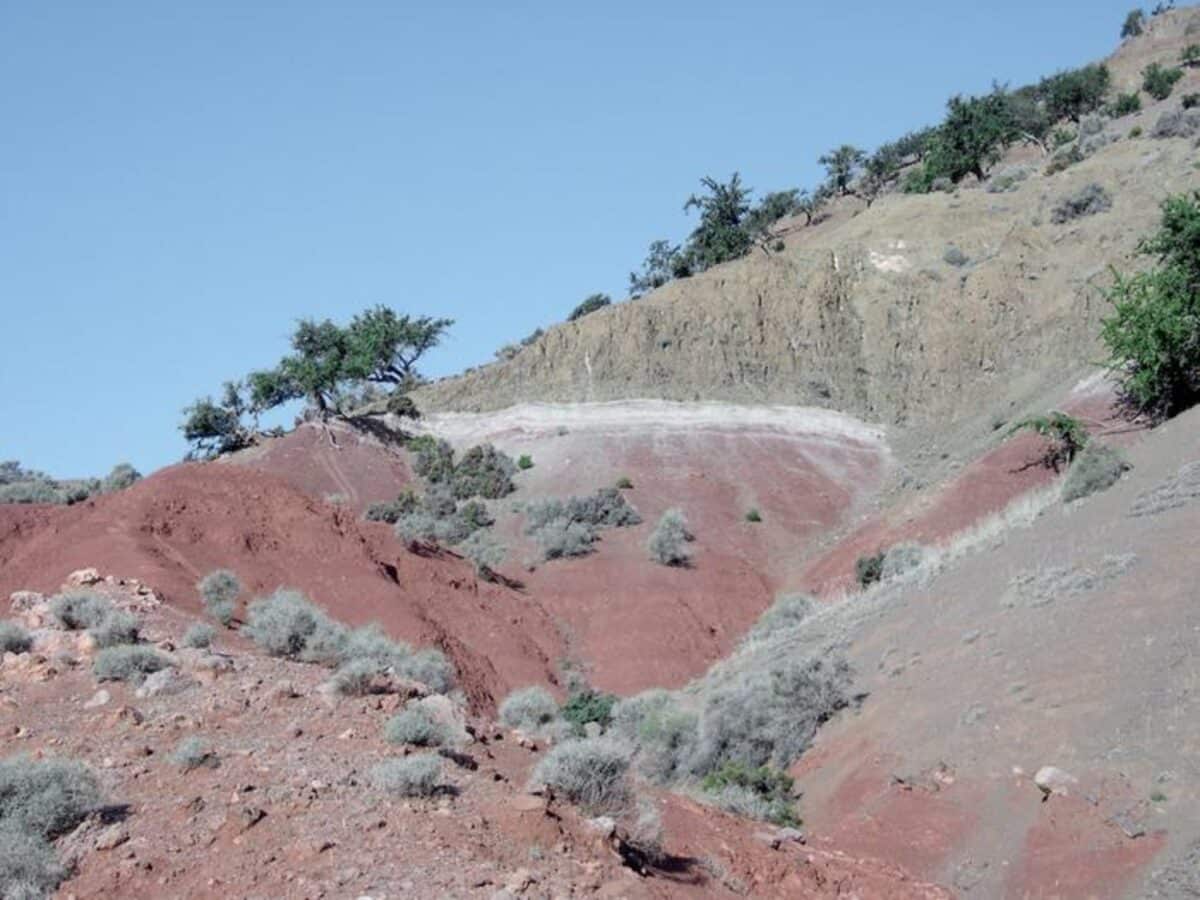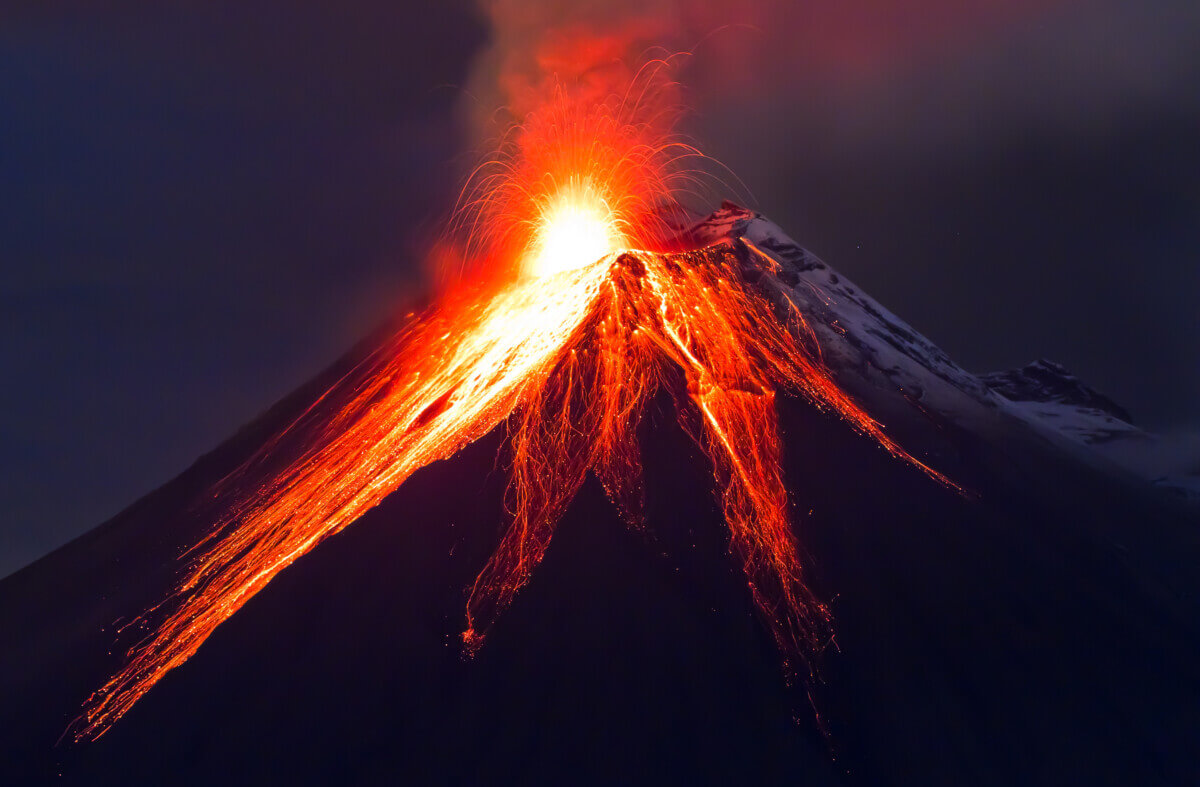
Early, possibly feathered dinosaurs like these may have survived ancient volcanic winters that wiped out their cold-blooded competitors. (Conceptual image generated by StudyFinds on Shutterstock AI Generator)
In a nutshell
- Ancient volcanic winters, not just carbon dioxide warming, likely triggered the end-Triassic extinction. New evidence shows that rapid sulfur dioxide releases from massive volcanic eruptions caused severe “volcanic winters” that devastated ecosystems within decades, setting the stage for dinosaur dominance.
- Volcanic eruptions occurred in fast, intense pulses lasting less than a century each. By analyzing magnetic signatures in ancient lava flows, scientists revealed that the Central Atlantic Magmatic Province (CAMP) eruptions were not slow and continuous, but came in sharp, rapid bursts, injecting catastrophic amounts of sulfur into the atmosphere.
- Feathered, insulated dinosaurs had a survival advantage during global cooling. Unlike many cold-blooded reptiles that went extinct, early dinosaurs with feathers or other forms of insulation were better equipped to survive the sudden, dramatic temperature drops caused by volcanic winters, giving them an evolutionary head start.
NEW YORK — When the ancient supercontinent Pangea began to break apart 200 million years ago, it unleashed volcanic hell on Earth. New research from the Columbia Climate School reveals that five rapid pulses of lava, each erupting for less than a century, spewed massive amounts of sulfur into the atmosphere. This triggered catastrophic cooling that wiped out countless species in what scientists call the end-Triassic extinction, the event that ultimately paved the way for dinosaur dominance.
A team of scientists studied ancient magnetic signatures in volcanic rocks to create the most precise timeline yet of the Central Atlantic Magmatic Province (CAMP) eruptions and their relationship to the end-Triassic extinction event, which wiped out much of Earth’s biodiversity before dinosaurs became the planet’s dominant land animals.
The findings, published in the Proceedings of the National Academy of Sciences, suggest that initial volcanic eruptions released sulfur that triggered devastating “volcanic winters”—periods of extreme cooling—that killed off many species within decades or centuries. Previous theories hypothesized that carbon dioxide emissions and warming were the primary drivers of the extinction.
The research focused on connecting the timing of volcanic activity with the extinction event. Their research indicates these eruptions occurred in pulses of intense activity rather than spreading evenly over millions of years as previously thought.

These volcanic winters weren’t small disturbances. The researchers found that early CAMP basaltic eruptions released sulfur at levels hundreds of times greater than the historic Laki eruption in Iceland, a 1783 eruption that caused widespread crop failures across Europe and North America and killed thousands of people through famine and respiratory illnesses.
Tracking Ancient Eruptions Through Earth’s Magnetic Field
Rather than relying solely on radiometric dating, this research used a clever technique to pinpoint when these eruptions occurred. The scientists analyzed paleomagnetic secular variation, essentially ancient recordings of Earth’s magnetic field preserved in volcanic rocks, from CAMP lava flows across three sites: the Fundy Basin in Canada, the Newark Basin in northeastern United States, and Morocco.
This approach allowed them to identify distinct “directional groups” of volcanic activity and correlate them across distant locations. Each directional group represents a brief eruptive episode lasting approximately a century or less, based on how Earth’s magnetic field changes over time.
By combining this magnetic data with high-precision uranium-lead dating and astronomical cycling evidence from sedimentary rocks, they established that the first four directional groups occurred during a roughly 40,000-year period around 201.5 million years ago.
What Delivered the Extinction Blow?

These eruptions unleashed an estimated 63,000 megatons of sulfur dioxide over a brief period, exponentially more than any volcanic eruption recorded in human history. For comparison, the 1991 Mount Pinatubo eruption, which temporarily cooled global temperatures by about 0.5°C, released approximately 20 megatons of sulfur dioxide.
Volcanic activity releases about 7 megatons of sulfur dioxide per cubic kilometer of lava. During explosive phases, this sulfur dioxide gets carried high into the atmosphere, forming sulfate aerosols that spread globally.
These aerosols reflect sunlight back into space, causing temporary but severe cooling— the “volcanic winter” effect. This makes sense based on how sudden the extinction event was. Carbon dioxide warming would have taken longer to manifest.
While carbon dioxide emissions from CAMP likely played a role in longer-term environmental changes, particularly in marine environments, the research team found that carbon dioxide alone couldn’t explain the extinction pattern or timing. Their calculations showed known CAMP lavas could have released only about 1,400 gigatons of carbon dioxide. This is far less than the minimum 14,000 gigatons needed to create the atmospheric changes seen in geological records.
How Feathered Dinosaurs Survived When Others Perished
Many large reptiles disappeared during the extinction event, but early dinosaurs, many of which had feathers or other insulation, managed to survive and eventually thrive. Meanwhile, large cold-blooded reptiles without insulation that dominated tropical regions before the extinction would have struggled to maintain their body temperatures during dramatic cooling events.
The volcanoes that helped dinosaurs rise to power by triggering these extinction-causing winters were, ironically, part of the same geological processes that would eventually create the Atlantic Ocean. The feathered, insulated dinosaurs that survived these volcanic winters eventually dominated our planet for over 150 million years. Their success story began not with a bang from space, but with volcanic winters that favored those already adapted to survive the cold.
Paper Summary
Methodology
The researchers collected 180 oriented samples from 37 sites in the North Mountain Basalt of Atlantic Canada’s Fundy Basin. They also analyzed 138 sample plugs from a continuous core section. These samples were then measured for their paleomagnetic properties – essentially the ancient magnetic signatures recorded in the rocks when they formed. The team combined this data with previous paleomagnetic data from Morocco and the northeastern United States to establish correlations between volcanic events across these locations. By identifying distinct “directional groups” in the magnetic records, they could determine which volcanic pulses occurred simultaneously. They integrated this data with high-precision uranium-lead dating and astronomical cycle evidence from sedimentary rocks to construct a detailed timeline of events.
Results
The study found that initial CAMP volcanism occurred in five distinct directional groups or pulses, each lasting less than a century. The first four pulses happened during a roughly 40,000-year period around 201.5 million years ago. Most importantly, the initial pulse coincided precisely with the end-Triassic extinction event. The researchers estimated these eruptions released about 63,000 megatons of sulfur dioxide – more than 500 times the amount released during the 1783 Laki eruption in Iceland. This rapid injection of sulfate aerosols likely caused severe volcanic winters, cooling the climate dramatically within decades. While carbon dioxide emissions from CAMP likely contributed to longer-term environmental changes, the researchers found that volcanic sulfur emissions better explain the sudden nature and timing of the extinction, particularly in terrestrial ecosystems.
Limitations
The paper acknowledges challenges in correlating extinction events in the marine realm due to fewer well-preserved marine sections containing both CAMP lavas and fossils. The researchers note that interpretation of the end-Triassic extinction in European marine sections is complicated by preservation differences, facies changes, and seismic disturbances. Additionally, the total volume of CAMP magmatism is still uncertain, with potentially undiscovered lava flows beneath the ocean. The carbon dioxide budget calculations also involve some uncertainty, as intrusive magmatism not visible at the surface likely contributed additional gases.
Funding and Disclosures
The research was supported by various NSF-EAR grants and institutional support including the Lamont Paleomagnetic Research Fund and the Board of Governors Research Fund at Rutgers. Field work in Morocco was supported by Onhym Maroc. The authors declared no competing interests.
Paper Publication Information
The paper “Correlation of sub-centennial-scale pulses of initial Central Atlantic Magmatic Province lavas and the end-Triassic extinctions” was authored by Kent, D.V., Olsen, P.E., Wang, H., Schaller, M.F., and Et-Touhami, M. (2024). It was published in the Proceedings of the National Academy of Sciences (Vol. 121, No. 46, e2415486121) on October 28, 2024.








Well that’s a reversal in conclusions and perhaps expectations for the future…